Each spring, Texas highway roadsides, country fields, and urban gardens take on blue as our beautiful bluebonnets start to bloom. Typically this bloom period is from March to May, and the bounty of blue depends on rain that fell the previous fall and winter.
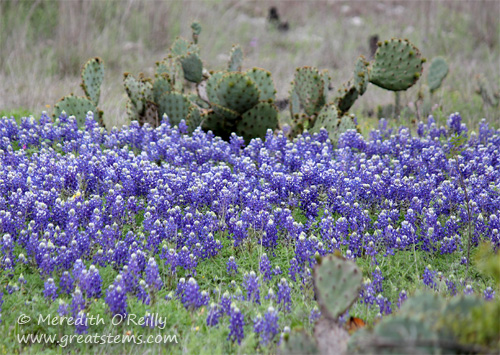 Bluebonnets are part of the legume, or bean, family. Like most other members of the legume family, they offer nitrogen-fixation through their root system’s symbiotic relationship with Rhizobia bacteria, giving them the excellent ability of being able to grow in poor, disturbed soils and at the same time bringing nitrogen back to that poor soil when they decompose.
Bluebonnets are part of the legume, or bean, family. Like most other members of the legume family, they offer nitrogen-fixation through their root system’s symbiotic relationship with Rhizobia bacteria, giving them the excellent ability of being able to grow in poor, disturbed soils and at the same time bringing nitrogen back to that poor soil when they decompose.
Bluebonnets require insect pollination, and bumblebees and honeybees take on this job quite readily. The flowers are designed to encourage this pollination. Let’s take a closer look.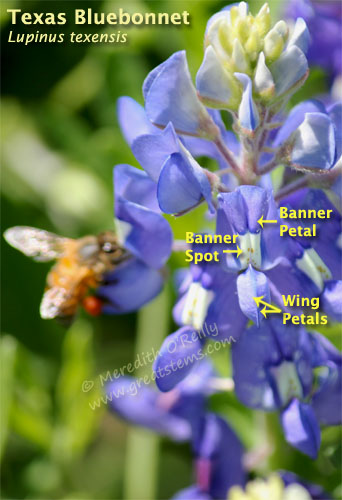
Bluebonnet flowers are made up of many florets. Each floret has 5 petals: the banner petal, 2 wing petals, and 2 petals that make up the keel (next photo). The banner petal forms the upper part of the floret. The center of this petal is called the banner spot, and it is this spot that acts as a target to attract bee pollinators. When the pollen is fresh and sticky, the banner spot is white, seen to bees as reflected UV light and appearing to them to be a nice landing spot. But as the floret and its pollen age, the banner spot turns a reddish-magenta color and becomes ignored by the bees, who can’t see red. Take a moment to watch bees buzzing around bluebonnets — which color banner spots do they visit the most?
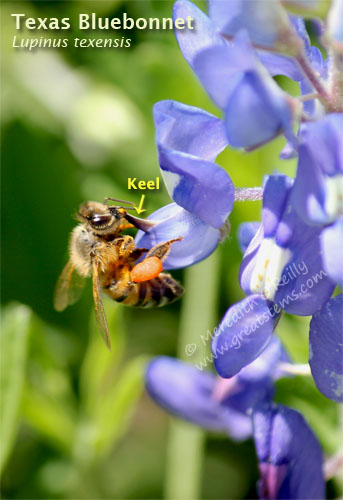
When a visiting bee lands on a bluebonnet floret’s wing petals, its weight lowers those petals to expose the keel, which is actually two petals that protect the floret’s reproductive parts, the stamens (which produce the pollen) and the pistil (which receives other pollen and produces seed). Here the bee collects pollen, naturally leaving other pollen grains behind to fertilize the floret, and when the bee flies to other florets, the wing petals return to their protective position over the keel. As the bee visits floret after floret, more pollination occurs. Florets that are not pollinated will not set seed.
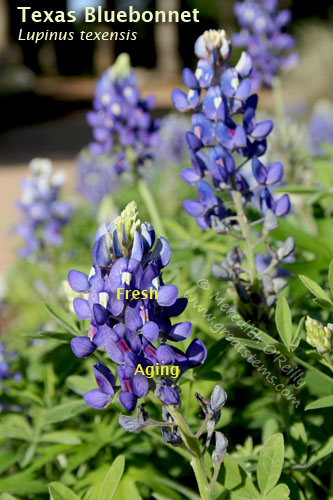 Any given bluebonnet is likely to show both fresh florets and aging florets. Even though a magenta banner spot indicates that a floret’s pollen has lost its viability, the floret may, of course, produce seeds if it was pollinated while it was fresh.
Any given bluebonnet is likely to show both fresh florets and aging florets. Even though a magenta banner spot indicates that a floret’s pollen has lost its viability, the floret may, of course, produce seeds if it was pollinated while it was fresh.
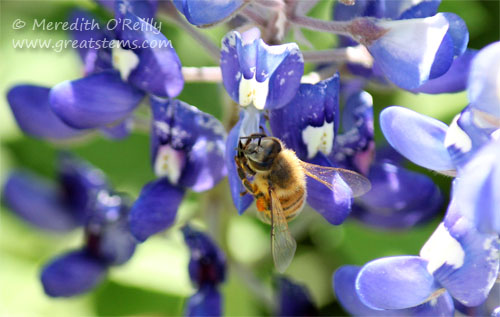 Because bluebonnets cannot self-fertilize, the decline in bee populations has a direct effect on how many seeds a bluebonnet can produce. One plant has the potential to produce many hundreds of seeds, but often only a small number typically result, simply due to the decrease in pollinator numbers. Please protect our pollinators and our wildflowers by not using pesticides!
Because bluebonnets cannot self-fertilize, the decline in bee populations has a direct effect on how many seeds a bluebonnet can produce. One plant has the potential to produce many hundreds of seeds, but often only a small number typically result, simply due to the decrease in pollinator numbers. Please protect our pollinators and our wildflowers by not using pesticides!
Another danger to bluebonnets and other native wildflowers, is the invasive Bastard Cabbage, a yellow flower of the mustard family (my son still prefers to call it Bad Word Cabbage, which seems equally appropriate). Active measures must be taken to control this bullying plant, whether it be mowing before the cabbage flowers go to seed, removing each entire plant with its tap roots, or overseeding with native plants such as Indian Blanket (Gaillardia). Studies are being done to determine the best course of action, but in the meantime, if you see Bastard Cabbage, yank it out if you can.
Here in Texas, we have 6 known native species of bluebonnets, and all are considered our state flower. There’s a long history regarding the bluebonnet’s status in Texas. When the bluebonnet was chosen as our state flower back in 1901, beating out the cotton boll and the prickly pear flowers, the Sandyland species Lupinus subcarnosus was recorded. But in the years following, many people felt the ever-popular Lupinus texensis, or Texas Bluebonnet, was a better choice. Both are endemic to Texas, but then what about our other larger-range and equally beautiful bluebonnets, such as the taller Big Bend Bluebonnet (Lupinus havardii)? In 1971 Texas legislators amended the law, stating that all native species of bluebonnet in Texas were our state flower. Problem solved.
Even before Texans fell in love with the bluebonnet, this attractive flower was the subject of lore and legend for Native Americans in the area, many of whom considered the bluebonnet a gift from the Great Spirit. One story is that the bluebonnets arrived with rain after a young orphaned girl sacrificed her precious doll to the Great Spirit in hopes of bringing an end to a terrible drought. Spanish explorers and missionaries upon their arrival in Texas also admired the blue-blooming flowers. The bluebonnet has been called el conejo (“the rabbit” — possibly for the tail-like tuft of new florets at the top of each Texas bluebonnet flower), Wolf Flower (hence the Lupinus genus), and Buffalo Clover.
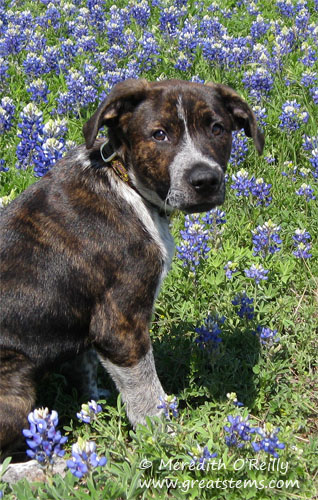
Our puppy in 2009 — he’s all grown up now!
A final note: It’s not actually illegal to pick bluebonnets, but it’s considered very rude and improper. We need bluebonnets to go to seed — please don’t pick them! And try very hard not to trample them while you are out picture taking!
Great and thorough information. I was so glad to see bluebonnets in Oregon last year.
And I just got the link to this bluebonnet song – hope you can use it.
I THINK I can remember how to translate it for playing in a Power Point show, if you want me to try.
http://www.youtube.com/watch?v=E07p3fphqGA&feature=youtu.be
I’m without speakers at the moment, but I’ll listen as soon as I can. I’ll bet it’s wonderful — thanks, Marilyn!
PUPPY!
As always, thanks for the plant lesson. I’ll have to forward this to some coworkers who insist that picking bluebonnets is illegal. (of course, I think every state has the “it’s illegal to pick the state flower” thing – I know Colorado does).
It’s illegal to pick them from people’s property (criminal trespass) and to damage public spaces. But technically, it’s not illegal to pick wildflowers. Here’s a link with more info that you can share with your coworkers, Katina: http://www.txdps.state.tx.us/director_staff/public_information/pr032602.htm
There it is! I’ve been waiting for one of the Texas garden bloggers to post some bluebonnet pix, and I got my wish. Gorgeous!
It hasn’t been our best year for bluebonnets here in Texas — the weather didn’t cooperate. Perhaps that’s why there have been fewer posts. And then there’s Bastard Cabbage, the invasive weed that’s bringing everyone down…. Still, we had enough patches that people still got to do their annual bluebonnet family photos!
Great article, quick and complete, all what I needed, here I was observing that my bluebonnets did not make seeds, and then I read this and saw that pollination was required, so I crossed my 2 plants, red and blue varieties and hope they will seed now!
My husband and I recently watched a documentary about the disappearance of bees and we are now interested in planting a bee garden. I don’t know anyone who has grown bluebonnets – I’ve only seen them as wildflowers in fields. Is it difficult to plant the seeds and get them growing? We live on a HUGE corner lot and I would much rather plant flowers and help the bees than see the weeds that are growing now! HA! We live in North Texas and there are bluebonnets all over the place so I think the climate is good… just wasn’t sure about growing them ourselves.
Dani, I didn’t have any trouble growing them from seed. They prefer poor soil rather than heavily composted, rich soil. Spread the seeds in the fall and let fall rains and cold winters help them germinate. You can also overseed somewhat to ensure a higher rate of success. Of course, then they might all germinate and you’ll have an abundance forevermore! Good luck!